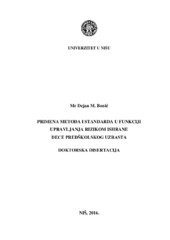Приказ основних података о дисертацији
Primena metoda i standarda u funkciji upravljanja rizikom ishrane dece predškolskog uzrasta
| dc.contributor.advisor | Stanković, Aleksandra | |
| dc.contributor.other | Miljković, Milena | |
| dc.contributor.other | Lazić, Vera | |
| dc.contributor.other | Bjelaković, Bojko | |
| dc.creator | Bonić, Dejan M. | |
| dc.date.accessioned | 2018-12-24T10:40:10Z | |
| dc.date.available | 2018-12-24T10:40:10Z | |
| dc.date.available | 2020-07-03T16:14:11Z | |
| dc.date.issued | 2018-09-05 | |
| dc.identifier.uri | https://nardus.mpn.gov.rs/handle/123456789/10437 | |
| dc.identifier.uri | http://eteze.ni.ac.rs/application/showtheses?thesesId=6357 | |
| dc.identifier.uri | https://fedorani.ni.ac.rs/fedora/get/o:1520/bdef:Content/download | |
| dc.identifier.uri | http://vbs.rs/scripts/cobiss?command=DISPLAY&base=70052&RID=534013846 | |
| dc.description.abstract | Nutrition is one of the most important factors in prevention of various diseases as well as improving the health care in preschool children. The HACCP system and other standards can be applied in every phase of the food chain starting from primary production with final consump-tion so as to eliminate hazards to human health caused by food. The aim of this study was to investigate the influence of HACCP standard efficiency verification on managing the health safety of the meals along with determining the correlation between the influence of good manufacturing and sanitary practices application to reduction of risks to preschool-age children’s health. Moreover, the objective of this research was a multidisciplinary observation of the risk management issues in providing safe food intended for preschool-age children. The research was conducted in the preschool children's institution "Pcelica" in Nis and in the Public Health Institute Nis. The research in the preschool children's institution "Pcelica" included: implementation and analysis of the principles of HACCP standards through a specific control of one meal (beans with salad) and sensory analysis of that meal and selected food (apples). We have conducted the analysis of the influence of temperature as the critical control point, as well as the analyses of the partial change of the technological process in terms of extending the cooking time and adding some ingredients to the recipe. At the Institute of Public Health Nis, in accredited testing laboratories of the Center for Hygiene and Human Ecology, there were conducted quarterly food testings in the period from 2011 to 2014. There were used dietary surveys and meals chemical analysis, as well as inspection of sanitary and hygienic conditions. The sensory analysis findings showed that all the parameters were bet-ter after a partial change of the technological process in terms of ex-tending the cooking time as well as different combinations of ingredi- ents and times when they are added to the main dish. Dietary test find-ings show somewhat greater level of proteins regarding the energy val-ue of meals, whereas fats and carbohydrates have somewhat lower val-ues as to those prescribed by the norms. As for the mineral substances, the level of calcium is slightly lower than prescribed as well as the lev-els of phosphorus, potassium and copper. The level of natrium was in-creased whereas levels of magnesium and iron were slightly below the prescribed norms. Testing vitamin contents in an average children's meal has shown that the level of vitamin B1 was slightly below the norm as well as the levels of vitamin PP. Level of vitamin C was slightly above the prescribed value. The results of the chemical analy-sis of the meal showed that the daily meal mass was within the stand-ard limits, the energy value was satisfactory. The level of proteins was somewhat higher whereas the level of fats and carbohydrates was so-mewhat lower than the prescribed norms for the chemical composition of the meal. The analysis of the macronutrient ratio in the total energy value of meals shows that the ratio of proteins, fats and carbohydrates was optimal. By analyzing the results of bacteriological analysis of swabs we find that in a given period there was the average of 0,55% of contaminated smears. With regard to the conducted research we can conclude that the re-search objectives have been achieved in terms of a multidisciplinary approach to the problem of nutrition of the preschool children. It also shows the effectiveness of HACCP standards in improving the safety of the final product and adequate risk management. | en |
| dc.format | application/pdf | |
| dc.language | sr | |
| dc.publisher | Универзитет у Нишу, Технолошки факултет, Лесковац | sr |
| dc.rights | openAccess | en |
| dc.rights.uri | https://creativecommons.org/licenses/by-nc-nd/4.0/ | |
| dc.source | Универзитет у Нишу | sr |
| dc.subject | Upravljanje rizikom | sr |
| dc.subject | Risk management | en |
| dc.subject | kontrola kvaliteta | sr |
| dc.subject | bezbednost namirnica | sr |
| dc.subject | HACCP standard | sr |
| dc.subject | ishrana dece predškolskog uzrasta | sr |
| dc.subject | quality control | en |
| dc.subject | food safety | en |
| dc.subject | HACCP standard | en |
| dc.subject | preschoolers' nutrition | en |
| dc.title | Primena metoda i standarda u funkciji upravljanja rizikom ishrane dece predškolskog uzrasta | sr |
| dc.type | doctoralThesis | en |
| dc.rights.license | BY-NC-ND | |
| dc.identifier.fulltext | http://nardus.mpn.gov.rs/bitstream/id/54734/Bonica_Dejana.pdf | |
| dc.identifier.fulltext | https://nardus.mpn.gov.rs/bitstream/id/54733/Disertacija.pdf | |
| dc.identifier.fulltext | https://nardus.mpn.gov.rs/bitstream/id/54734/Bonica_Dejana.pdf | |
| dc.identifier.fulltext | http://nardus.mpn.gov.rs/bitstream/id/54733/Disertacija.pdf | |
| dc.identifier.rcub | https://hdl.handle.net/21.15107/rcub_nardus_10437 |



